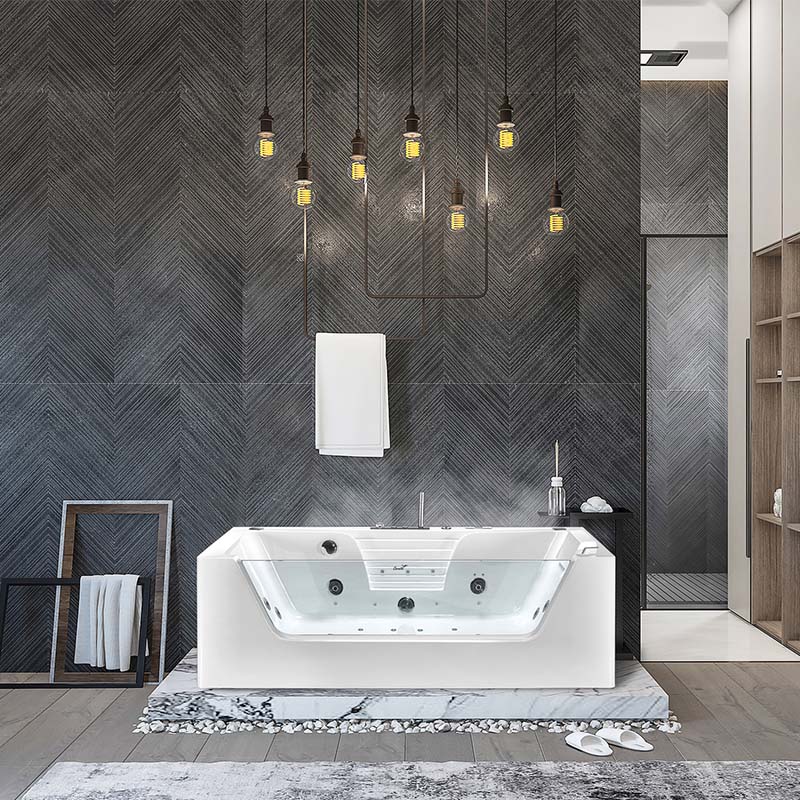Key features and considerations related to bathroom bathtubs
2023-10-16
A bathroom bathtub, commonly referred to simply as a bathtub or tub, is a large, typically water-filled vessel used for bathing and relaxation. Bathtubs are a prominent fixture in bathrooms and come in various shapes, sizes, materials, and styles to accommodate different preferences and bathroom layouts. They serve as a central feature in bathroom design and are used for bathing, soaking, and, in some cases, showering.
Here are some key features and considerations related to bathroom bathtubs:
1. Materials: Bathtubs can be made from various materials, each with its own characteristics and aesthetics. Common materials include:
- Acrylic: Lightweight, affordable, and available in various shapes and sizes. Acrylic bathtubs are easy to maintain.
- Porcelain-Enameled Steel: Durable and resistant to chipping and staining. They provide a classic, glossy appearance.
- Cast Iron: Extremely durable and long-lasting. Cast iron tubs retain heat well, providing a comfortable soaking experience.
- Fiberglass: Lightweight and affordable, fiberglass tubs are easy to install but may not be as durable as other materials.
- Solid Surface: Made from composite materials, solid surface tubs are known for their modern and sleek appearance. They can be custom-shaped and are durable.
2. Types of Bathtubs:
- Alcove Bathtub: Designed to fit within three walls, alcove bathtubs are common in standard bathroom layouts and are often combined with a shower.
- Freestanding Bathtub: These tubs are not attached to any walls and are often positioned as a focal point in the bathroom. They come in various shapes, including clawfoot, pedestal, and modern designs.
- Drop-In Bathtub: Installed within a deck or surround, drop-in tubs provide a clean and integrated look. They are customizable in terms of size and shape.
- Corner Bathtub: Designed to fit into a corner of the bathroom, these tubs are space-saving and offer a unique design element.
- Whirlpool or Jetted Bathtub: Equipped with water jets for hydrotherapy and relaxation, these tubs provide a spa-like experience.
- Soaking Bathtub: Deep and spacious, soaking tubs are designed for extended relaxation and deep soaking baths.
3. Size and Dimensions: Bathtubs come in various sizes to accommodate different bathroom sizes and user preferences. Consider the available space in your bathroom and the desired level of comfort when selecting a size.
4. Installation: Depending on the type of bathtub, installation methods may vary. Freestanding tubs require more floor space and plumbing adjustments, while alcove and drop-in tubs are installed against walls or within a built-in enclosure.
5. Style and Design: Bathtubs contribute significantly to the overall aesthetics of the bathroom. Consider the bathtub's shape, style, color, and finish to match your bathroom decor and personal taste.
6. Functionality: Think about how you plan to use the bathtub. If relaxation is a priority, consider whirlpool or soaking tubs. If space is limited, a combination of a bathtub and shower might be a practical choice.
7. Accessibility: For individuals with mobility concerns, consider options like walk-in bathtubs with low entry thresholds and built-in handrails for added safety.
8. Maintenance: Different materials may require different cleaning and maintenance routines to keep the bathtub in good condition. Be sure to follow manufacturer recommendations.
Bathroom bathtubs offer a space for relaxation and personal care within the home. Choosing the right bathtub involves considering factors such as material, type, size, style, and functionality to create a comfortable and aesthetically pleasing bathing experience.



